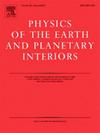Core-surface kinematic control of polarity reversals in advanced geodynamo simulations
IF 1.9
3区 地球科学
Q2 GEOCHEMISTRY & GEOPHYSICS
引用次数: 0
Abstract
The geomagnetic field has undergone hundreds of polarity reversals over Earth's history, at a variable pace. In numerical models of Earth's core dynamics, reversals occur with increasing frequency when the convective forcing is increased past a critical level. This transition has previously been related to the influence of inertia in the force balance. Because this force is subdominant in Earth's core, concerns have been raised regarding the geophysical applicability of this paradigm. Reproducing the reversal rate of the past million years also requires forcing conditions that do not guarantee that the rest of the geomagnetic variation spectrum is reproduced. These issues motivate the search for alternative reversal mechanisms. Using a suite of numerical models where buoyancy is provided at the bottom of the core by inner-core freezing, we show that the magnetic dipole amplitude is controlled by the relative strength of subsurface upwellings and horizontal circulation at the core surface. A relative weakening of upwellings brings the system from a stable to a reversing dipole state. This mechanism is purely kinematic because it operates irrespectively of the interior force balance. It is therefore expected to apply at the physical conditions of Earth's core. Subsurface upwellings may be impeded by stable stratification in the outermost core. We show that with weak stratification levels corresponding to a nearly adiabatic core surface heat flow, a single model reproduces the observed geomagnetic variations ranging from decades to millions of years. In contrast with the existing paradigm, reversals caused by this stable top core mechanism become more frequent when the level of stratification increases i.e. when the core heat flow decreases. This suggests that the link between mantle dynamics and magnetic reversal frequency needs to be reexamined.

先进地球动力学模拟中极性反转的核-表面运动学控制
在地球历史上,地磁场以不同的速度经历了数百次极性逆转。在地核动力学的数值模型中,当对流强迫增加超过一个临界水平时,倒转发生的频率就会增加。这种转变以前与力平衡中惯性的影响有关。因为这种力在地核中是次要的,所以人们对这种范式的地球物理适用性提出了关注。再现过去百万年的反转速率也需要强迫条件,而这些条件不能保证再现地磁变化谱的其余部分。这些问题促使人们寻找替代的逆转机制。利用一套由内核内部冻结在核心底部提供浮力的数值模型,我们表明磁偶极子振幅受地下上升流和核心表面水平环流的相对强度控制。上升流的相对减弱使系统从稳定状态变为反向偶极态。这个机构是纯运动学的,因为它与内部力平衡无关。因此,预计它将适用于地核的物理条件。地下上升流可能受到最外层岩心稳定分层的阻碍。我们表明,弱分层水平对应于一个几乎绝热的地核表面热流,一个单一的模型再现了观测到的地磁变化,范围从几十年到数百万年。与现有的模式相反,当分层水平增加时,即当核心热流减少时,这种稳定的顶部核心机制引起的反转变得更加频繁。这表明需要重新研究地幔动力学和地磁反转频率之间的联系。
本文章由计算机程序翻译,如有差异,请以英文原文为准。
求助全文
约1分钟内获得全文
求助全文
来源期刊

Physics of the Earth and Planetary Interiors
地学天文-地球化学与地球物理
CiteScore
5.00
自引率
4.30%
发文量
78
审稿时长
18.5 weeks
期刊介绍:
Launched in 1968 to fill the need for an international journal in the field of planetary physics, geodesy and geophysics, Physics of the Earth and Planetary Interiors has now grown to become important reading matter for all geophysicists. It is the only journal to be entirely devoted to the physical and chemical processes of planetary interiors.
Original research papers, review articles, short communications and book reviews are all published on a regular basis; and from time to time special issues of the journal are devoted to the publication of the proceedings of symposia and congresses which the editors feel will be of particular interest to the reader.
 求助内容:
求助内容: 应助结果提醒方式:
应助结果提醒方式:


